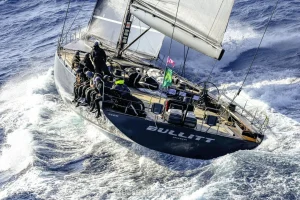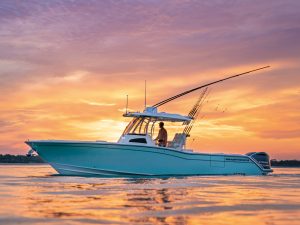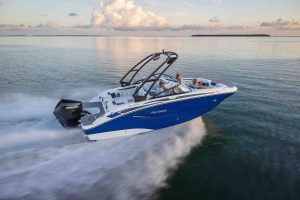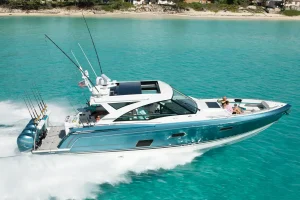Motorsailer Boats: Exploring Their Versatility and Advantages
Motorailer boats are a unique category of vessels that combine the best of both worlds, offering sailors the opportunity to experience the quiet and eco-friendly aspects of sailing while also having the power and convenience of a motor yacht. These versatile boats come in a wide range of sizes and can accommodate varying numbers of passengers, making them suitable for different types of boating activities such as overnight cruising and day sailing.
One of the key advantages of motorsailer boats is that they provide a spacious cabin similar to a motor yacht, while also being equipped with sails for environmentally friendly propulsion. This design allows boat enthusiasts to enjoy the sport of sailing, wind conditions permitting, while having the option to switch to motor power when needed. The dual-nature of these boats makes them a popular choice for those who want to maintain flexibility during their time on the water.
History of Motorsailer Boats
While motorsailers possess characteristics of both sailboats and motorboats, their roots lie in traditional sailboats. In the early 20th century, sailors began to experiment with adding engines to sailing vessels, providing auxiliary power for times when winds were weak or unfavorable. This led to the development and eventual popularity of motorsailers as a unique class of vessels.
One key moment in the history of motorsailers came when Jim Leishman, co-founder and vice president of Pacific Asian Enterprises (PAE), collaborated with his brother, chief designer Jeff Leishman, and president Dan Streech. In the 1970s, '80s, and '90s, they designed and built more than 200 Mason sailboats that were intended for world cruising. These boats laid the foundation for the modern motorsailer's design and functionality, making them more versatile and appealing to sailors and powerboaters alike (Power & Motoryacht).
Over time, motorsailers have evolved in design, comfort, and performance. Early motorsailers had less-efficient sailing systems and heavy engines which limited their sailing abilities. Today, advancements in technology have given motorsailers more efficient engines and better sailing performance, making them a popular choice for those who want the best of both worlds. Some notable motorsailer brands to emerge in recent years include Nordhavn and Island Packet Yachts, both of which have contributed innovative designs and features to the market (Britannica).
Modern motorsailers are equipped with features that highlight the convenience and versatility of combining motor and sail power. By offering a comfortable and sheltered steering station, as well as the ability to achieve near hull speed using the engine or sails, these boats cater to a diverse range of boating enthusiasts who appreciate the advantages of both sail and power (Wikipedia).
Types of Motorsailer Boats
Motorsailer boats come in various designs and sizes, catering to the diverse needs of recreational sailors and those who desire the best of both worlds - sailing and motor-powered capabilities. In this section, we will discuss a few popular types of motorsailer boats.
One notable type is the Fisher 34, known for its traditional design and sturdy build. The Fisher 34 offers both comfort for leisurely cruises and the ability to tackle challenging weather conditions when necessary.
Another popular motorsailer is the Moody Carbineer 44. This boat offers ample living space and excellent sea-keeping characteristics, making it a favorite among long-distance cruisers.
The Nauticat 331 is a versatile option, with its spacious cabin and easy sail handling. It suits both novice sailors and experienced enthusiasts who desire the convenience of motor power and the thrill of sailing.
Custom built motorsailers also exist for those who require specific features or preferences. These boats can be tailored to meet unique requirements, such as increased fuel efficiency, optimized living spaces, or specialized rigging arrangements.
It is important to consider your individual needs and preferences when selecting a motorsailer boat, as each type offers distinctive advantages and trade-offs. By understanding their features and functionality, you can make an informed decision on the perfect motorsailer for your sailing adventures.
Key Features and Benefits
A motorsailer is a type of boat that combines the characteristics of both sailing vessels and motor-driven boats. They offer a versatile boating experience, allowing owners to take advantage of wind power and engine propulsion as needed. The key features and benefits of motorsailers include:
Fuel efficiency: Motorsailers can rely on sail power when the wind conditions are favorable, saving fuel and reducing operating costs. This allows for longer trips without the need to refuel as often as in a purely motor-driven boat. Moreover, motorsailers usually have more efficient engines, which can drive them at near hull speed in moderate seas (Wikipedia).
Comfort and stability: The hull design of motorsailers provides more stability than traditional sailboats. With a wider beam, they have a more comfortable and spacious interior, perfect for accommodating passengers on extended voyages. The added weight of the engine also contributes to increased stability when sailing in heavy seas.
Versatility: One of the main benefits of motorsailers is their versatility, allowing owners to use either sail power, engine propulsion, or a combination of both depending on the conditions. As they are designed to be both 100% sailing vessel and 100% power vessel (Kasten Marine), they can perform well under various circumstances.
Potential for self-sufficiency: The ability to switch between sail and motor power can be advantageous for long-distance cruisers, providing a level of self-sufficiency not found in traditional sailboats or motor yachts. With proper equipment and solar panels, a motorsailer can generate its own power and significantly reduce reliance on external sources.
Customizable configurations: Motorsailers are available in various designs and configurations, allowing for customization based on the owner's preferences and intended use. Owners can choose from pilothouse, aft cabin, or center cockpit layouts, with many additional features and options to tailor the boat to their specific needs.
Popular Motorsailer Models
Motorsailer boats, also known as "motorsailors," are versatile sailing vessels that combine the benefits of both motor and sail power. They are popular among cruising enthusiasts for their ability to provide both fuel efficiency and sailing performance. In this section, we will explore a few popular motorsailer models that have gained recognition in the boating community.
First on our list is the Fisher 30, a classic British-built motorsailer known for its robust construction and seaworthiness. This model features a spacious wheelhouse and accommodations, making it ideal for long-distance cruising or living aboard. The hull design provides excellent stability, allowing the boat to perform well under both motor and sail power.
Next, we have the Nauticat 38, a Finnish-built motorsailer that has earned a reputation for its outstanding build quality and comfortable interior. The Nauticat 38 offers ample room for its occupants, and its impressive sailing performance has made it a popular choice among cruising sailors. Its elegant exterior and interior design also contribute to its popularity.
Lastly, the LM 32, a Danish motorsailer known for its combination of practicality and attractive design. The LM 32 features a spacious cockpit and comfortable accommodations, making it suitable for both weekend trips and extended voyages. Its solid construction and versatile sailing capabilities have garnered the attention of cruising enthusiasts worldwide.
These are just a few examples of popular motorsailer models that have made their mark in the boating world. Each model offers a unique set of features, making them well-suited for different cruising preferences and requirements.
Selecting the Right Motorsailer
When searching for the perfect motorsailer, considering your primary usage and specific needs is crucial. Factors such as size, displacement, and layout should be taken into account alongside your sailing experience and intended cruising areas.
Some popular motorsailer models include the Fisher 34, Moody Carbineer 44, and Nauticat 331. Each model has unique features and characteristics that cater to different sailing needs and preferences.
Common factors to consider when selecting a motorsailer include:
- Size and Layout: The boat's size and layout should match your intended use and number of passengers. Consider factors such as cabin arrangement, storage space, and overall boat length.
- Sailing Performance: Evaluate the boat's performance under sail, including its stability, speed, and ability to point upwind. A motorsailer should provide a balance between sailing and motoring capabilities.
- Engine Power: Ensure the boat's engine is powerful enough for your intended use. For extended cruising or operating in challenging conditions, a reliable and robust engine is essential.
- Displacement: Lighter displacement boats are generally faster and more responsive, while heavier displacement boats offer increased stability and comfort in rough seas.
- Maintenance: Consider the ongoing maintenance and upkeep requirements of the boat. A more straightforward design can make maintenance easier and more cost-effective.
When selecting a motorsailer, take the time to thoroughly research and compare different models. It's also a good idea to test sail or charter similar boats to get a feel for how they perform and handle in various conditions.
Maintenance and Care
Maintaining a motorsailer boat involves regular inspections of the engine, sails, rigging, and hull to ensure its optimum performance and longevity. It is crucial to address any wear and tear, corrosion, or damage before taking the boat out on the water.
The engine of a motorsailer should be routinely checked, including oil levels, cooling systems, and fuel filters. Additionally, it's important to change the engine's oil and filters as suggested by the manufacturer. Regularly inspecting the boat's fuel lines and connections is also essential to minimize the risk of leaks or engine failures.
The sails and rigging should be examined for any signs of damage, wear, or chafing. This involves checking the sail material, stitching, and any hardware connections such as cleats, winches, and pulleys. Make sure to clean the sails using fresh water and mild soap to remove any dirt or salt build-up, allowing them to dry thoroughly before storage.
Another vital aspect of motorsailer maintenance is hull care. Regularly cleaning the hull with mild soap and water helps prevent algae and barnacle build-up that can affect the boat's performance. Additionally, applying antifouling paint during scheduled boat maintenance can further protect the hull from unwanted growth.
Keeping the boat's electrical and safety systems in check is equally important. Inspect the batteries, wiring, and connections regularly to ensure they are in good working order. Don't forget to check safety equipment, such as life jackets, flares, and fire extinguishers, to ensure they are up to date and functioning properly.
Finally, remember that proper storage and winterization are crucial components of motorsailer care. When not in use, store the boat in a covered area to protect it from the elements. During winter months, take the necessary steps to winterize the boat, including draining water systems, adding fuel stabilizer, and properly storing sails and rigging components.
Conclusion
In summary, motorsailer boats offer a unique combination of sailing and motor-powered capabilities, making them an ideal choice for those looking for versatility in their boating experience. With the ability to harness both wind and engine power, owners can enjoy the best of both worlds, as highlighted by PassageMaker.
While some motorsailer boats may lack certain features, such as an inside helm station in the case of the Shannon Shoalsailer 35, they often provide greater freedom in navigating various water conditions and environments. The decision between the motor yacht and sailboat ultimately comes down to personal preference, as eloquently discussed in WorldwideLuxuryYacht's comparison of motor yachts and sailboats.
Whether you are planning an ocean voyage or a leisurely cruise in shallow waters, a motorsailer boat can cater to a wide range of needs and preferences. As you consider which type of vessel is best for you, take into account factors such as comfort, economy, and performance. By doing so, you can make a more informed decision and find a boat that meets your expectations and enhances your time on the water.










